Snake! Oh, wait, maybe not. Are there animals that look like snakes, move like snakes, and disguise themselves as snakes, but aren’t snakes? Several species will copy the appearance of snakes to survive. Let’s take a look at some of the fascinating animals that look like snakes but aren’t!
1. Legless Lizards (Glass Lizards)
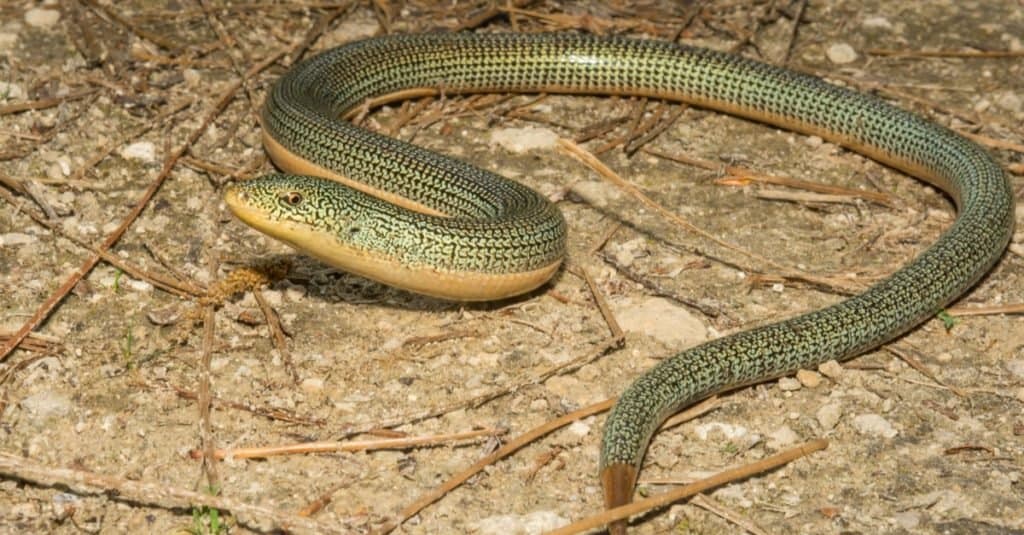
Although the glass lizard has no legs, it is a lizard – not a snake.
©Jay Ondreicka/Shutterstock.com
Why wouldn’t you refer to legless lizards as snakes? They certainly look like snakes! There are a few characteristics that make them true lizards and not snakes. First, they can blink. Snakes do not have eyelids but a clear membrane that covers their eyes. Secondly, legless lizards have ear holes, whereas snakes do not have external ears. Lastly, legless lizards can regrow their tails if broken off. Snakes can not regrow or regenerate body parts. Legless lizards evolved over time to lose their legs (similar to snakes, but snakes did this long before legless lizards). So, although they both look similar, they evolved from a different family line which accounts for their differences now. A few of the more common legless lizards include:
- Mimic Glass Lizard: 15-26 inches long, brown or tan, dark stripes on the side, sometimes speckled
- Eastern Glass Lizard: 18-42 inches, yellowish, greenish, or brownish, can be found in the southeast states of the United States
- Island Glass Lizard: 15-24 inches, brownish or yellowish with a dark stripe along both sides of the body, found in the southeast of the United States as well as offshore islands
- Slender Glass Lizard: 14-22 inches, yellowish to brownish, dark stripe down the back, skinnier than the Eastern Glass Lizard, found in a larger portion of the southeast states of the United States.
2. Owl Butterflies (in the chrysalis stage)
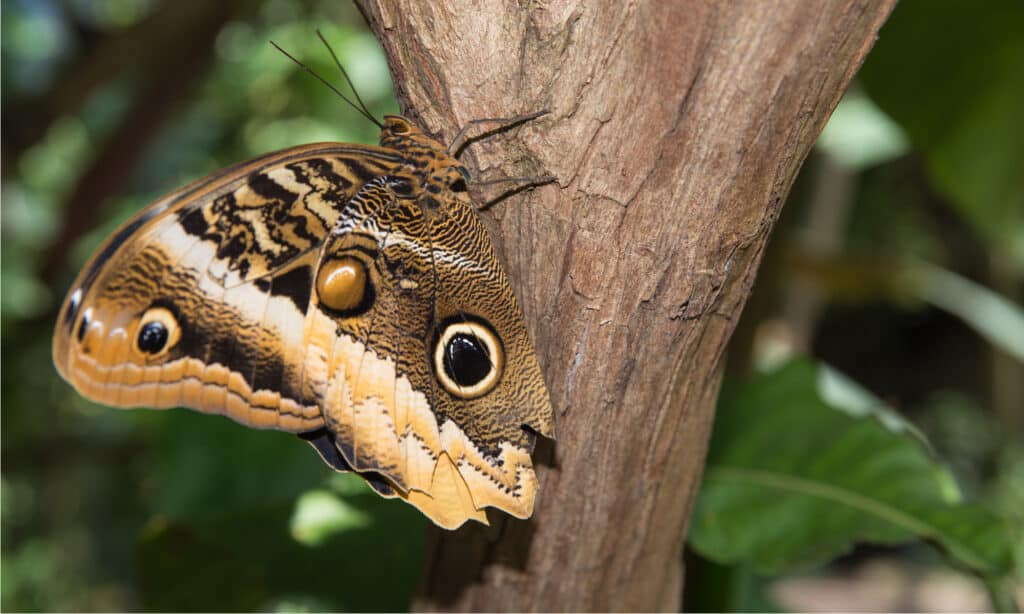
Owl butterflies, in their chrysalis stage, have a coloration that resembles the scales of a snake.
©Eric Celebrezze/Shutterstock.com
A butterfly doesn’t look like a snake. But the owl butterfly, when it is in the chrysalis stage, looks like the head of a peering snake! The tip of the chrysalis is raised, looking like the snout, and two spots resemble the eyes of a snake. The coloration and texture of the chrysalis also resemble the scales of a snake. Birds are going to pass on that for dinner for sure!
3. Eurasian Wrynecks

Eurasian wrynecks can make sounds like a hissing snake.
©Yuriy Balagula/Shutterstock.com
Eurasian wrynecks are birds in the woodpecker family. Although they may not look like snakes, they imitate snakes by moving their bodies and head in a snake-like fashion. They can even make a sound like a hissing snake. They’re also called the Jynx torquilla, or Jynx bird, and it is thought that the saying to “Jynx someone” came from the belief that these strange birds were trying to put a spell or curse on someone.
4. Caterpillars
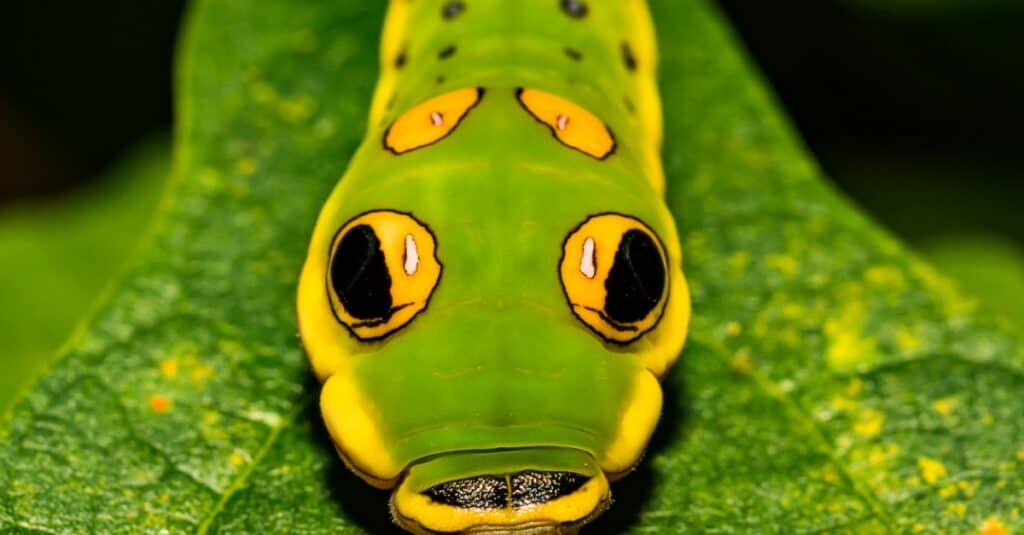
This spicebush swallowtail caterpillar is one of the animals that look like snakes!
©iStock.com/JasonOndreicka
There are a variety of caterpillars that disguise themselves to look like snakes. Two dark spots that look like the eyes of snakes and coloration patterns often help them look more fierce than they are. One even raises the front of its body as if it is ready to strike like a snake! Here are a few caterpillars that look like snakes:
- Great Orange Tip Caterpillar
- Elephant Hawk-Moth Caterpillar
- Spicebush Swallowtail Caterpillar
- Red Helen Swallowtail Caterpillar
- Eastern Tiger Swallowtail Caterpillar
5. Asian Jumping Earthworms

Asian jumping earthworms can grow twice as fast as other earthworms.
©iStock.com/Arrlxx
Asian jumping earthworms are an invasive species in the United States that have a negative effect on native plants, invertebrates, salamanders, and some birds. They can reproduce more quickly and grow twice as fast as other earthworms, so they are taking over more and more habitats. Although they are much smaller than a typical snake, they move like snakes when disturbed. Most earthworms expand and contract their body segments to move forward, but the Asian jumping earthworm moves like a snake. These earthworms get their name from the startling jumping motion they are also capable of making!
6. Snake-Eels
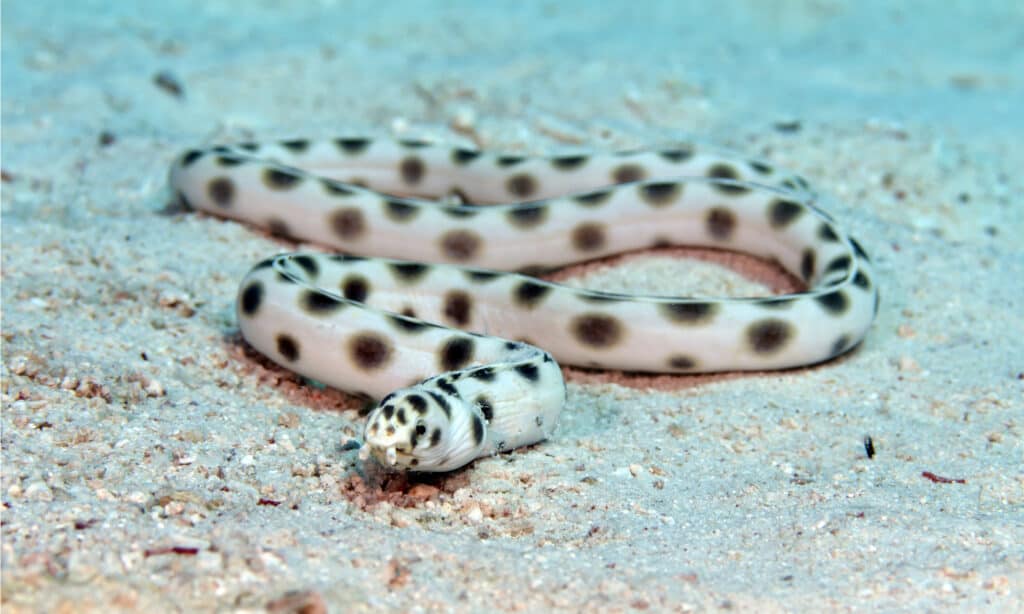
Snake eels can grow to be four feet long.
©orlandin/Shutterstock.com
If you are walking along the seashore in Texas and are startled by a snake’s head poking out of the sand, you might have found a snake-eel. An article in Newsweek in October 2020 described a snake-like animal that had been seen swimming just offshore of Padre Island, Texas. It was smaller than a sea snake and pale in color. Later, researchers identified it as a snake-eel. Snake eels are found in other states besides Texas but typically live along the shoreline. The snake-eel is sometimes called the burrowing-eel because of its habit of burrowing in the sand with just its head visible. The spotted snake-eel really looks like a snake because it can grow to be four feet long and is tan with dark brown markings. Now you have one more creature to watch out for on your day at the beach.
7. Slow Worm
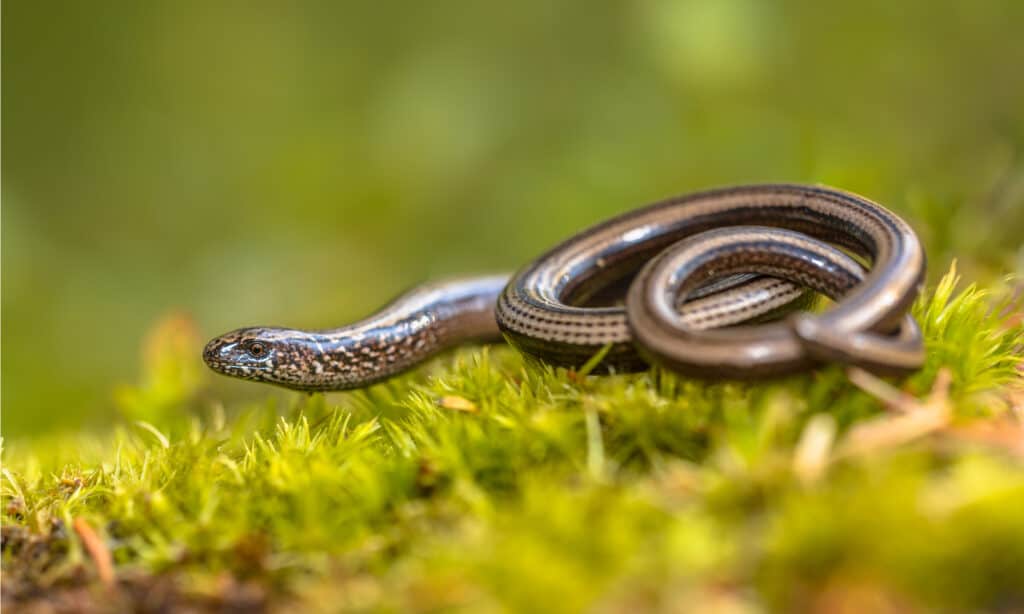
Slow worms can be found in western Eurasia.
©Rudmer Zwerver/Shutterstock.com
As the name implies, you would think this is a worm (a slow one), but it is actually another kind of legless lizard. Slow worms can grow to be 15-20 inches long and have yellowish-grey, shiny skin. You might find one in your garden or compost pile, and they like sunning themselves in warm weather. They live in western Eurasia.
8. Caecilians
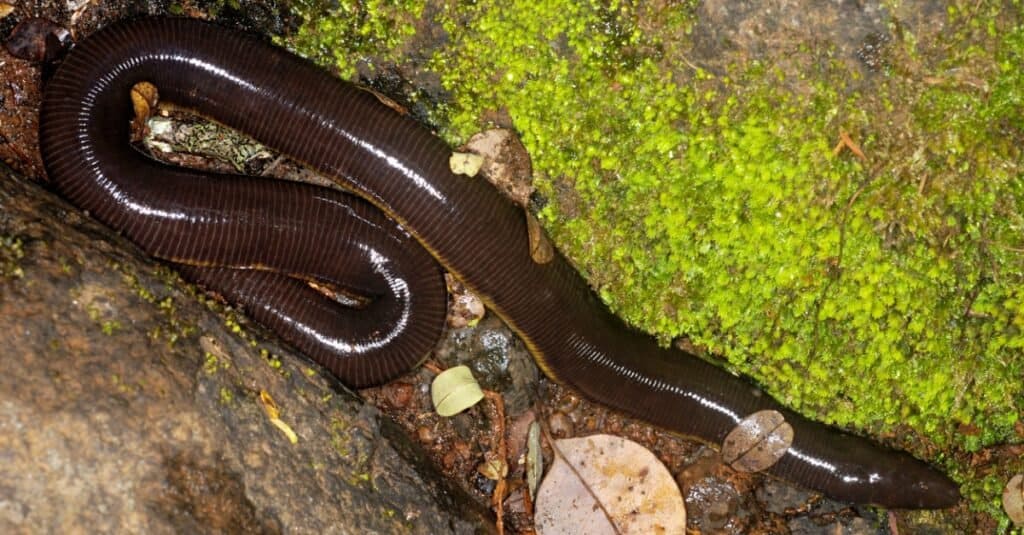
Caecilians look like worms or snakes but are amphibians.
©RealityImages/Shutterstock.com
These snake-like animals are not worms and not snakes but legless amphibians. They look like large earthworms but have sharp teeth for eating earthworms. There are 180 species of caecilians, with some living on land and others being aquatic. The largest one in South Africa, the C. thompsoni, can grow to be about five feet long! These animals are located throughout the world, but little is known about them because they spend most of their time burrowed underground.
9. African Giant Black Millipede
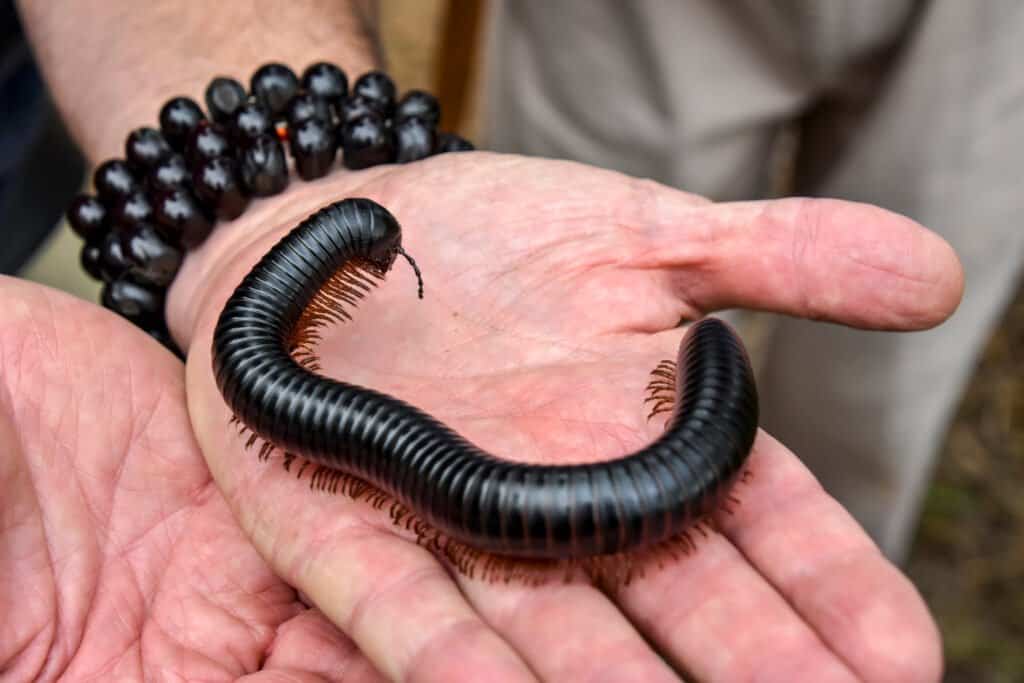
The African giant black millipede looks like a snake from above until you spot the 300+ tiny legs!
©Wandel Guides/Shutterstock.com
If you saw a 15-inch African giant black millipede skit across the floor, you might mistake it for a snake. From the top view, these millipedes are black and snake-like. They are thicker than a pencil and can move quickly. You’ll quickly be able to identify one as soon as you see the rows of tiny legs (not quite a million) that line the millipede’s underside. Most millipedes have around 300 legs. Centipedes’ legs stick out to the side, but because millipedes have their legs under their body, they could be mistaken for a snake!
10. Western Three-Toed Skink
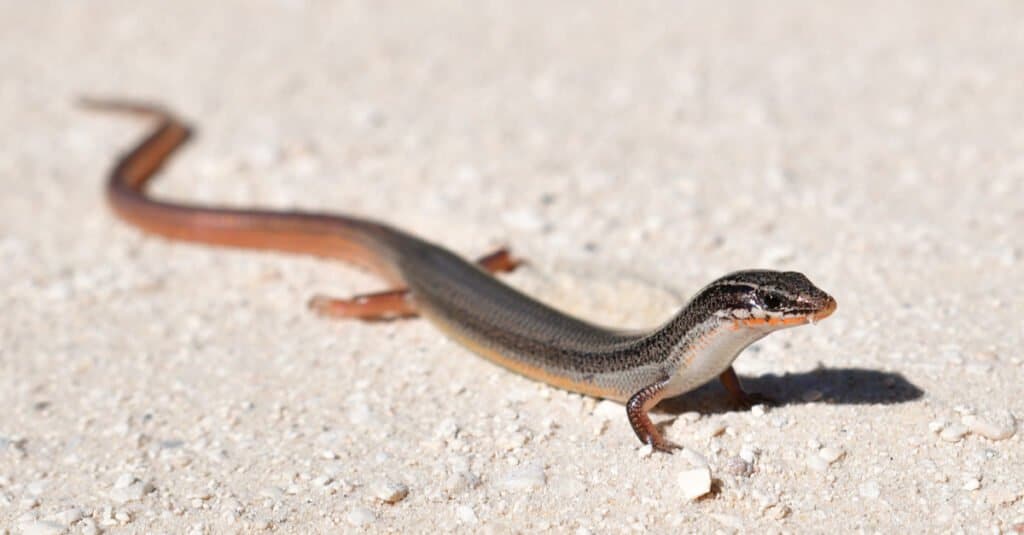
Skinks, in general, are longer and skinnier than most lizards.
©Chase D’animulls/Shutterstock.com
Perhaps a thousand years from now, the western three-toed skink will be called the western legless skink? They still have two tiny appendages near the front of their bodies, but they seem to be non-functioning. Skinks are a kind of lizard, but they typically have shorter legs than lizards and skinnier bodies. The western three-toed skink can be found in parts of Europe and grows to be 15-17 inches long. They have long skinny yellow and brown stripes that are the length of their bodies. Check back in a thousand years to see if this skink has evolved to be legless!
The photo featured at the top of this post is © iStock.com/JasonOndreicka
Thank you for reading! Have some feedback for us? Contact the AZ Animals editorial team.






